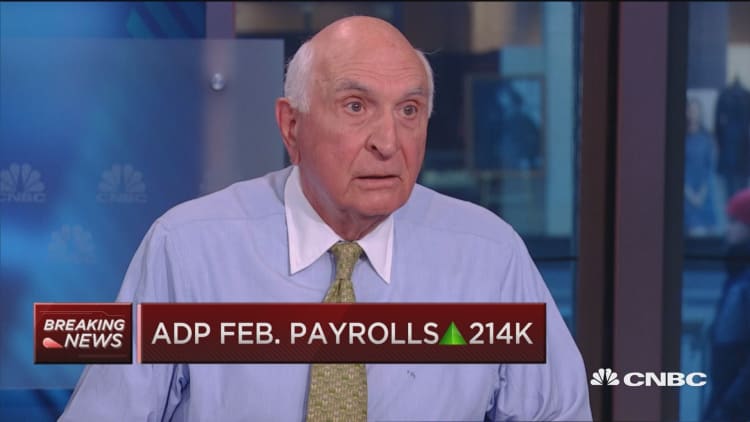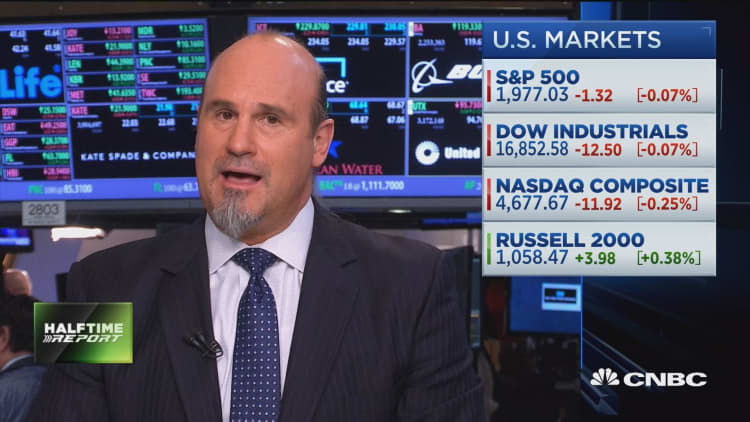
Markets are already tilting toward Friday's jobs report, but data on the services sector Thursday could prove important, given January's weaker reading.
The recent spate of improving economic reports, including ISM manufacturing data this week, has reduced some market anxiety about the potential for a recession. Services sector data are important because the figures were weaker than expected in January, and had remained strong in the months before even as the much smaller manufacturing sector showed contraction.
"When you have shocks expected in financial markets and they don't materialize, then expectations have to adjust up again," said Steven Wieting, global chief investment strategist at Citi Private Bank. "It doesn't mean the expansion will suddenly get really strong, but our slow, disappointing economic expansion is still underway." Wieting said concerns about China and the global economy remain, but market fears were overblown.
The ISM nonmanufacturing survey for February is released at 10 a.m. ET Thursday and is expected at 53, down from 53.5 in January. It had been 55.8 the month earlier and in January a big part of the decline was in business activity. There is also Markit services PMI, and that is expected at 50.5 after a surprising decline to 49.8 in January. Any reading below 50 signals contraction, and that drop had spooked traders.
The big data, however, are the February employment report Friday morning, and it's expected to show 190,000 jobs and an unemployment rate of 4.9 percent, according to Thomson Reuters.

Wieting said he believes the economy has been working through an inventory overhang, and it will make its way through it barring other shocks. "I think economists' expectations are not really low. Economists' expectations seem reasonable. The market worries seem unreasonable," he said. But even if the data continue to improve, he does not expect the Fed to raise rates at its next meeting in March.
"I don't think the Fed plays a role in the outlook immediately. It's been too unsettled for them to tighten this month," Wieting said, adding he does expect the U.S. central bank to hike later in the year.
Stocks meandered Wednesday after Tuesday's big gains, with the market finding support in firmer oil prices. The rose 8 points to 1,986.
West Texas Intermediate crude rose modestly to $34.66 per barrel, in part on comments from Venezuela that 15 oil producers now agree to meet on a production freeze. Crude briefly rose above $35 per barrel, a key resistance level, and if it should break that and hold above it, traders say it would be a bullish sign.
Jack Ablin, chief investment officer of BMO Private Bank, said oil is showing all the signs of bottoming, and it could start to lose its hold on the equity market. "I think maybe as investors believe the rot is pretty much out of this thing, maybe now they can go back in and start looking at valuations and fundamentals again," said Ablin. "Obviously, if oil takes a turn for the worst, all bets are off."
Besides services data, there are jobless claims, and productivity and costs at 8:30 a.m. ET.
Natural gas inventory data is released at 10:30 a.m. ET on Thursday by the government. Nat gas prices fell 3.7 percent to $1.678 per million British thermal units on Wednesday, the lowest price for a front-month contract since Feb. 26, 1999, according to Dow Jones.
There are also earnings from Kroger, Royal Ahold, Barnes & Noble, Joy Global and Ciena before the bell. Hewlett Packard Enterprise, Broadcom, Wingstop, H&R Block and Planet Fitness report after the close.
Dallas Fed President Rob Kaplan speaks at 10:45 a.m. ET on the economy and monetary policy.


